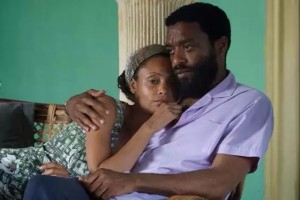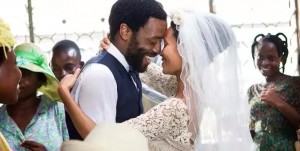 “You must never behave as if your life belongs to a man.” Words to live by, and perhaps the abridged thesis of Chimamanda Ngozi Adichie, recently made a pop culture heroine with an extensive quoting by Beyoncé on her latest album. She was already a celebrated novelist, at the forefront of new African literature, and her most celebrated novel, 2006’s Half of a Yellow Sun, finally makes its way to the big screen thanks to first-time writer-director Biyi Bandele. By necessity, Bandele’s adaptation is missing the vital narrative voices that make Adichie’s novel so incisive and diverse in its political, social, sexual and racial outlook, but it sadly isn’t the only thing lost in translation.
“You must never behave as if your life belongs to a man.” Words to live by, and perhaps the abridged thesis of Chimamanda Ngozi Adichie, recently made a pop culture heroine with an extensive quoting by Beyoncé on her latest album. She was already a celebrated novelist, at the forefront of new African literature, and her most celebrated novel, 2006’s Half of a Yellow Sun, finally makes its way to the big screen thanks to first-time writer-director Biyi Bandele. By necessity, Bandele’s adaptation is missing the vital narrative voices that make Adichie’s novel so incisive and diverse in its political, social, sexual and racial outlook, but it sadly isn’t the only thing lost in translation.
Twin sisters Olanna (Thandie Newton) and Kainene (Anika Noni-Rose) are educated members of Nigerian high society, invited to the best parties and keeping company with the finest people. It’s a privileged existence, coloured by their divergent choice in lovers. For Kainene, Richard (Joseph Mawle), a white British novelist who received a grant to write about Nigeria; for Olanna, Odenigbo (Chiwetel Ejiofor), a cultured political revolutionary. As the 1960s progress, the political situation after Nigeria’s independence from the Commonwealth becomes increasingly unstable, causing continual ructions in the sisters’ lives.
Bendele seems more concerned with the latter part of that narrative equation. Adichie’s novel is alternately narrated by Olanna, Richard and Odenigbo’s houseboy Ugwu (John Boyega), but Bendele eschews narration and sets his focus heavily on the sisters, accidentally reworking the story into a sibling soap opera. Well, of sorts – even the tension between the sisters has gone missing, making the undertones of class and political differences in their relationship seem unimportant. Adichie’s novel is an intricate masterpiece that indelibly weaves these threads together; Bendele evidently recognises what power the novel holds, but is far from matching the craft that realised it.
 Bendele takes the novel’s expansive focus and turns it in on itself. Feminist commentary becomes provocative personal drama, but the two don’t seem to tie together, as Bendele is too concerned with the love lives of the sisters. It might be because he’s cast two prominent, if inconsistent actresses, and feels the need to provide them with adequate theatrics. Rose’s learnt English accent fits better than Newton’s actual one, and her approach to the character works better, too, proving more of a irritant to the situations with her refined, somewhat superior attitude and pose. Kainene gradually fades from the story and Olanna dominates, but Newton is only able to grasp the surface of a character resigned to rather dull decisions.
Bendele takes the novel’s expansive focus and turns it in on itself. Feminist commentary becomes provocative personal drama, but the two don’t seem to tie together, as Bendele is too concerned with the love lives of the sisters. It might be because he’s cast two prominent, if inconsistent actresses, and feels the need to provide them with adequate theatrics. Rose’s learnt English accent fits better than Newton’s actual one, and her approach to the character works better, too, proving more of a irritant to the situations with her refined, somewhat superior attitude and pose. Kainene gradually fades from the story and Olanna dominates, but Newton is only able to grasp the surface of a character resigned to rather dull decisions.
The violent political unrest is mostly confined to black-and-white British newsreel footage, bar two dramatic set pieces, which are thrilling within the context of the film but ultimately rather bloodless for a conflict that burns with fiery shades of red on the page. Constantly comparing a film to a book might seem unfair, but the elements of promise in Bendele’s adaptation make the lack of political import and historical power distressing. The reality of the Biafran years, the conflicts of intellect and race and gender are all glimpsed, but never really felt. Half of a Yellow Sun the films fits the name more than the sun, which glowed with a fiery orange sun; the film does feel like half of what it could have been.
Half of a Yellow Sun is in cinemas from Friday 11 April.




